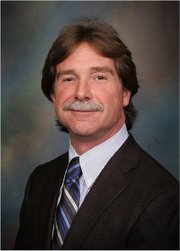J.B. Hunt Transport Services Inc. and other transportation companies have enjoyed success in persuading more customers to move freight from trucks to railways.
Now, they want to make sure the business stays there.
J.B. Hunt's Chief Executive Officer John Roberts and Chief Financial Officer David Mee discussed the challenges facing continued growth in intermodal transportation during a 45-minute question-and-answer session Wednesday at the Barclays Industrial Select Conference in Miami. Much of the discussion centered on the ongoing capacity and congestion issues on the rails and their effect on the intermodal sector.
"The risk is that -- as we've discussed with our rail partners -- we start to hurt the brand image of what is intermodal," Roberts said. "It took a long time to create a trust in that kind of service for our customers. We need to make sure we don't put that at risk. I don't think that's going to happen. I don't think the railroad guys want that to happen."
Intermodal transportation is the movement of freight involving more than one mode, whether it's by trucks, trains or boats. J.B. Hunt -- which was the nation's third-largest for-hire carrier in 2013 -- is regarded as the industry leader in intermodal transportation. J.B. Hunt's website reports having the largest fleet of company-owned 53-foot containers and one of the largest private drayage fleets across a nationwide network of rail partners, which includes BNSF and Norfolk Southern railways.
The financial importance of intermodal transportation to the Lowell-based company's success is evident. J.B. Hunt reported $1.61 billion in revenue for the fourth quarter of 2014, with $958 million of it coming from its intermodal sector. The company's intermodal revenue was up 5 percent, while income grew 6 percent to $128.8 million despite the challenges from limited capacity and rail service concerns.
But the intermodal giant acknowledged there are speed bumps to navigate for continued growth.
"We're nowhere near where we need to be or where we've been in the past, but we are definitely hoping for and seeing some signs of improvement in rail velocity and reliability," Roberts said.
Mee said the recent -- and ongoing -- difficulties in achieving growth levels the company has been accustomed to centers largely on issues with rail service. One example: Much of the freight J.B. Hunt handles moves through Chicago, which has had congestion problems for years.
"There's a lot of volume that's running through there," Mee said. "So the next phase these folks will have to deal with is how do you deal with Chicago? That's going to take a longer period of time to sort out. Is that going to be entirely our head wind and our growth rate? No. Will it be part of it? Sure."
J.B. Hunt isn't alone among the top intermodal providers hoping it can be cleared up in the near future.
Richard Stocking, president and chief operating officer of Phoenix-based Swift Transportation, said congestion affected the company's service levels and profitability in 2014.
Dave Yeager, chairman and CEO of Illinois-based Hub Group Inc., said his company faced challenges with rail service during the fourth quarter of 2014 as well.
"The service challenges created significant inefficiencies within our intermodal network, and while we do believe that rail service will incrementally improve near-term, it is not expected to become more normalized until the second half of the year," Yeager said during the company's fourth-quarter earnings conference call with investors earlier this month. "However, we continue to be very optimistic about the future of intermodal. Despite service issues and lower fuel costs, the industry continues to grow as customers take advantage of the cost savings through intermodal conversions."
Roberts said the railroads have started to become more proactive to create some relief.
The nation's major freight railroads are hoping to alleviate some of the issues by spending an estimated $29 billion to build, maintain and grow the rail network in 2015, according to the Association of American Railroads. The organization said the spending will go toward new equipment and locomotives, the installation of new track and bridges, the raising of tunnels, and new technology.
The association also estimated the hiring of 15,000 new employees to help match the growing demand.
"Intermodal for railroad is new business," Roberts said. "It's incremental business, and there is more to be had out there. ... I'm convinced in talking to the railroads, as they see this as a good long-term investment and realize the need to make sure the service gets better and stays in that reliability band that lets us continue to convert customers from highway to rail."
Roberts said he was optimistic the service level in the intermodal sector could return to an acceptable threshold as early as the mid-year but added, "it's not going to be back to what we've seen in the past."
Still, the challenges haven't altered J.B. Hunt's thinking on the value of intermodal service.
"While it's not as consistent as we'd like it to be, the service provided by intermodal is still, comparably speaking, better than truckload," Mee said. "The temporary spikes in demand that create the incredibly tight market in the truckload space gets very frustrating to a customer that needs to have its goods to market on a certain periodic and consistent time frame.
"In intermodal, you might pound your fist and get frustrated with the fact that your on-time service used to be in the mid-90s and now all of a sudden it's in the high 80s. The fact is, it's still in the high 80s."
SundayMonday Business on 02/22/2015


